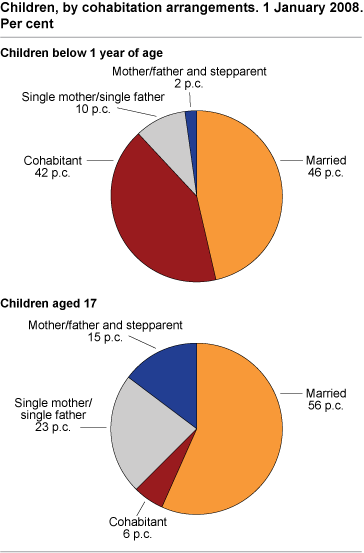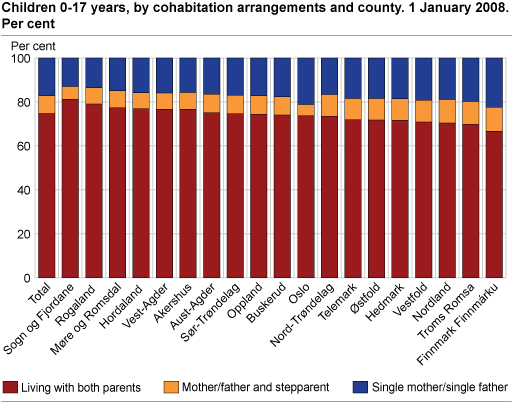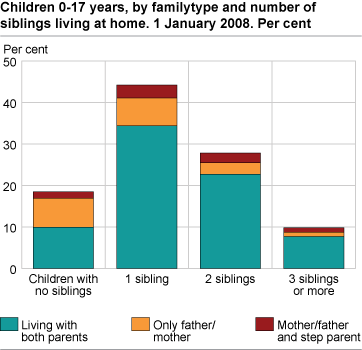Content
Published:
This is an archived release.
Fewer children live with married parents
The number of children with parents who are married is falling steadily, while the number of children whose parents are cohabitants is increasing. On the whole, three out of four children live with both their parents and one out of four lives with one parent.
At the beginning of 2008, the number of children in Norway was 1 089 000. 57 per cent of children who live at home have married parents, a decrease from 62 per cent in 2001. Slightly more than 17 per cent had cohabitating parents, an increase from almost 15 per cent in 2001. The proportion of children who live with one parent increased in the same period from 23 to 25 per cent. The statistics only include children who live with at least one parent.
In relative terms, the number of children with married parents is highest in Agder and Rogaland counties, while the number of children with cohabiting parents was highest in Trøndelag and Nordland counties. The northernmost counties and Vestfold had the highest numbers of children who live with one parent.
Most parents with young children cohabit
In relative terms, the proportion of cohabiting parents is highest for children under one year of age. In this age group, 42 per cent have cohabiting parents. Among children aged five, 21 per cent have cohabiting parents. This figure decreases with the age of the children, and among children aged 17 only 6 per cent have cohabiting parents. There are several reasons for this. First of all, it was much more common to marry than to cohabit 17 years ago. Second, many cohabiting parents get married as the children become older. And finally, many parents don’t stay together.
One in four in Oslo does not live with siblings an only child
Slightly more than 18 per cent of all children do not have sisters or brothers living at home. The proportion of children without siblings has increased steadily from 17 per cent in 2001. In relative terms, Oslo had the highest number of children without siblings with 25 per cent. Sogn og Fjordane county has the largest proportion of children with siblings.
|
In these statistics, children are defined as persons aged 0-17 years who are registered as living with at least one parent. Persons aged 0-17 years who do not live at home are therefore not included. Persons who married or gave birth before the age of 18 are also not included. In register based statistics, the place of residence is based on the address or residence stated in the population register, whereas in sample surveys the respondents themselves provide information about place of residence. Empirically, the number of cohabitants based on registers is below the number resulting from field surveys. Hence, the proportion of children with cohabiting parents in register based statistics is lower than in statistics based on field surveys, while the proportion of children who live with only one parent is higher. |
Tables:
- Table 1 Children 0-17 years, by number of parents in the family, the parents' cohabitation arrangements and the child's age. 2001, 2005, 2006, 2007 and 2008. Per cent.
- Table 2 Children 0-17 years, by number of parents in the family, the parents' cohabitation arrangements, siblings living at home and the child's age. 2001, 2005, 2006, 2007 and 2008
- Table 3 Children 0-17 years, by number of parents in the family, the parents' cohabitation arrangements and county. 2001, 2005, 2006, 2007 and 2008. Per cent
- Table 4 Children 0-17 år, by type of siblings living at home and the child's age. 2001, 2005, 2006, 2007 and 2008. Per cent
- Table 5 Children 0-17 år, by type of siblings living at home and county. 2001, 2005, 2006, 2007 and 2008. Per cent
- Table 6 Children 0-17 years, by number of siblings and parents living at home and the parents' cohabitation arrangements. 2001, 2005, 2006, 2007 and 2008. Per cent
- Table 7 Children 0-17 years, by number of siblings and county. 2001, 2005, 2006, 2007 and 2008. Per cent
- Table 8 Children 0-17 years, by number of siblings and the child's age. 2001, 2005, 2006, 2007 and 2008. Per cent
The statistics is published with Families and households.
Contact
-
Statistics Norway's Information Centre
E-mail: informasjon@ssb.no
tel.: (+47) 21 09 46 42



